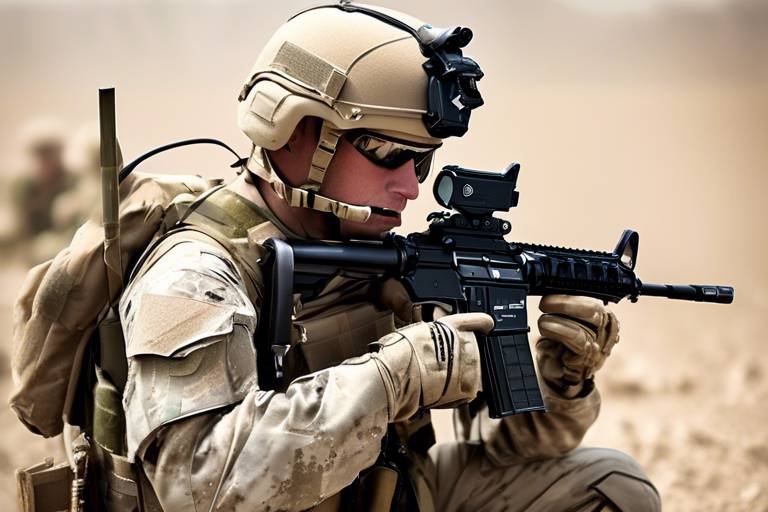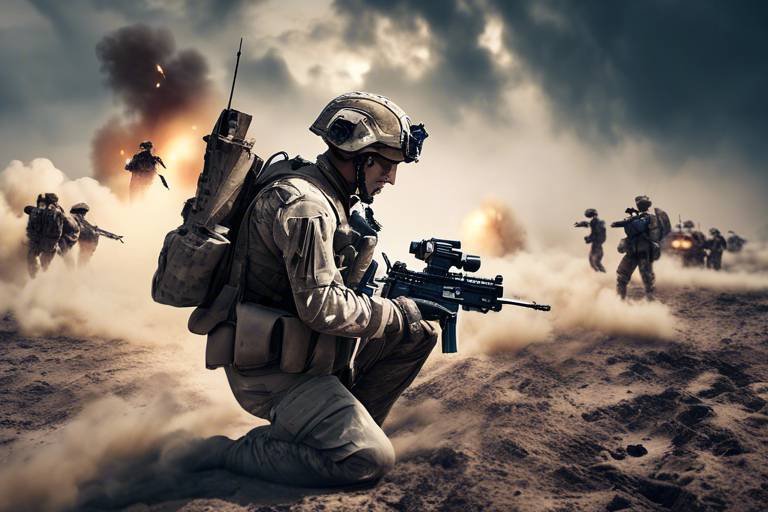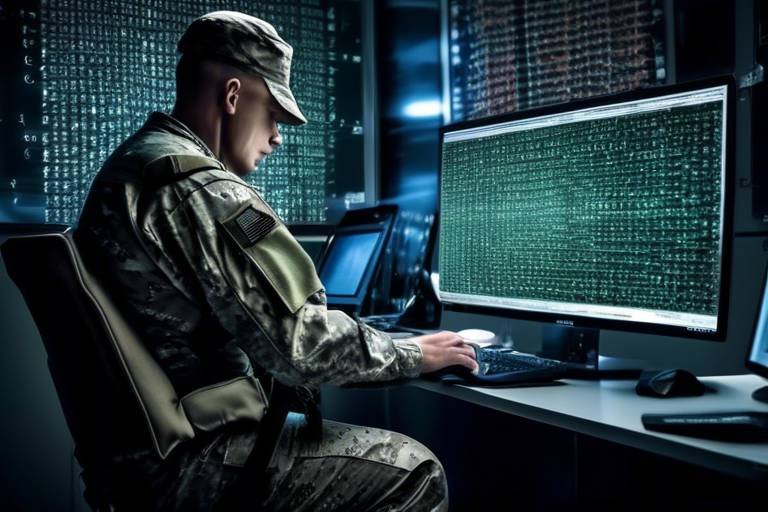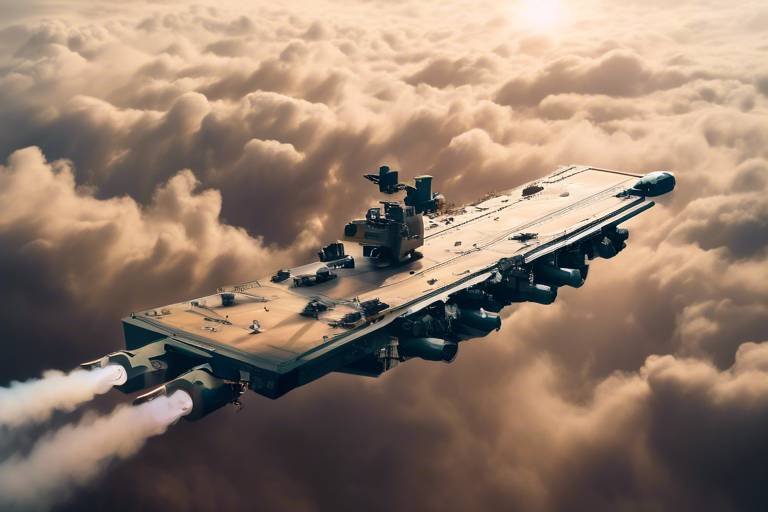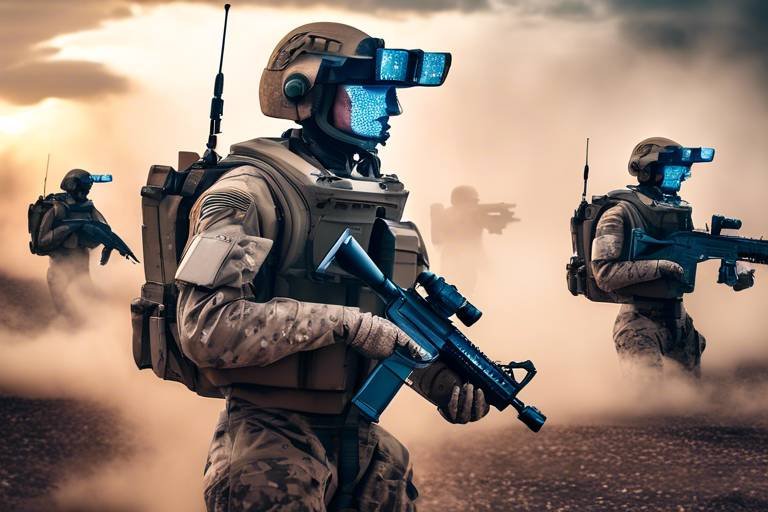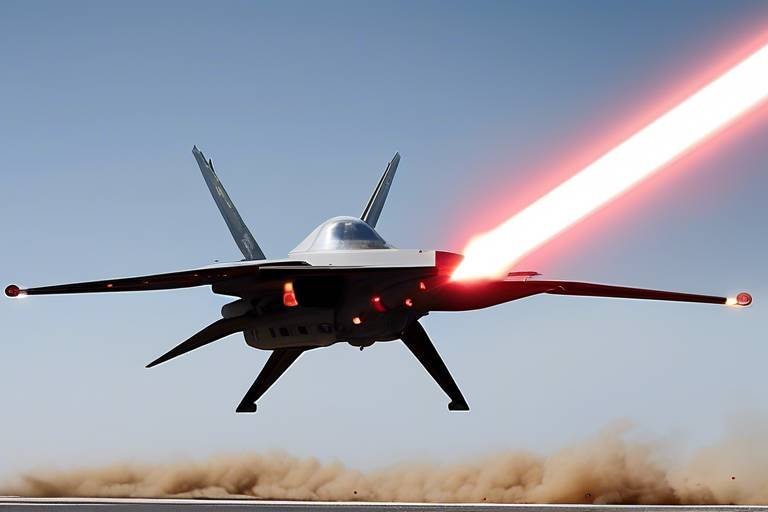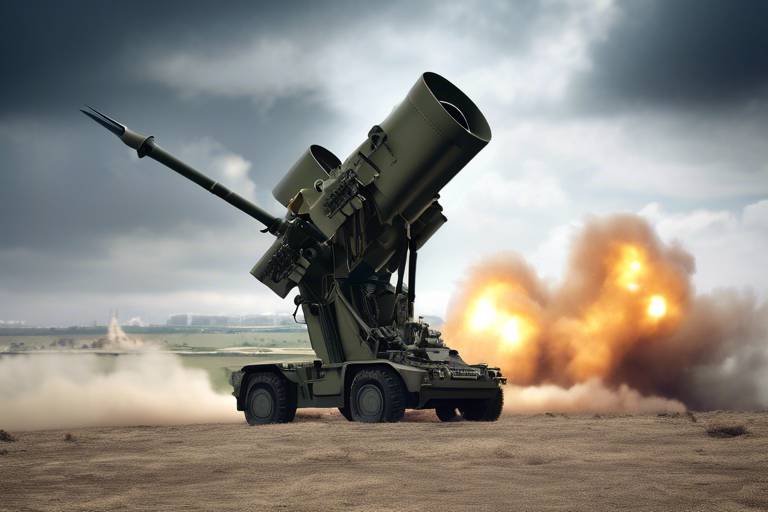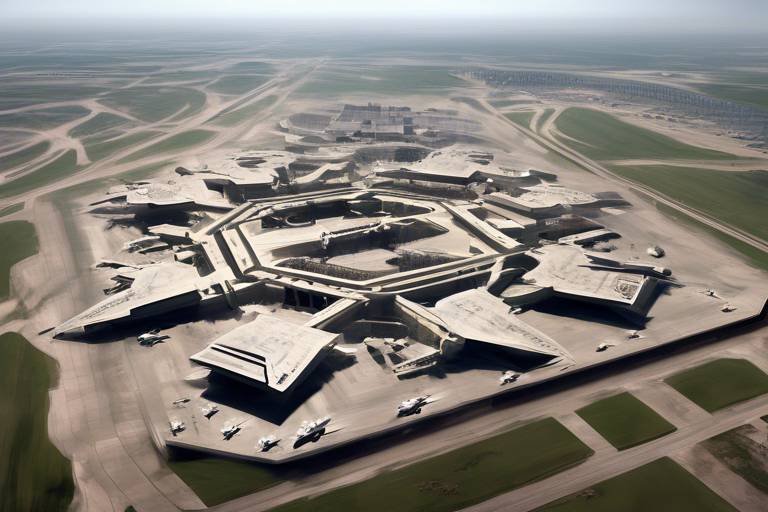The Role of AI in Combat Search and Rescue Operations
In today's fast-paced world, the integration of artificial intelligence (AI) into various fields is revolutionizing how we approach complex tasks. One of the most critical areas where AI is making a significant impact is in combat search and rescue operations. These high-stakes missions often take place in unpredictable environments, where every second counts, and the ability to make quick, informed decisions can mean the difference between life and death. AI enhances the efficiency and effectiveness of these operations by providing vital tools and insights that empower rescue teams to perform at their best.
Imagine being in a war zone, where chaos reigns, and time is of the essence. Rescue teams face numerous challenges, from navigating treacherous terrains to identifying the safest routes for evacuation. With AI at their disposal, these teams can analyze vast amounts of data in real-time, allowing them to make informed decisions swiftly. This capability not only improves response times but also enhances operational efficiency, ensuring that resources are utilized effectively and potential hazards are identified and mitigated promptly.
The application of AI in combat search and rescue operations is multifaceted. It begins with enhancing decision-making. AI systems can sift through data from various sources—such as satellite imagery, weather reports, and on-ground intelligence—to provide rescue teams with actionable insights. This real-time data analysis ensures that teams are not only aware of the current situation but can also anticipate changes that may affect their operations. For instance, if a storm is approaching, AI can alert teams to adjust their plans accordingly, potentially saving lives in the process.
Furthermore, the integration of AI with drones has transformed how search and rescue missions are conducted. Drones equipped with AI technology can autonomously cover large areas, capturing real-time imagery and data that enhance situational awareness. This means that instead of relying solely on ground teams, which can be limited by visibility and access, aerial drones can scout difficult terrains and identify missing personnel much faster. The autonomous navigation capabilities of these drones allow them to adapt to changing environments, significantly reducing the risks faced by rescue teams on the ground.
Another crucial aspect of AI's role in these operations is its ability to collect and transmit vital data. Drones can gather information during missions and send it back to command centers, facilitating better planning and coordination among rescue teams. This seamless communication is essential, especially in high-pressure situations where every moment counts. The enhanced communication systems provided by AI ensure that all team members are connected, even in the most challenging environments, thereby increasing the likelihood of mission success.
Predictive analytics is yet another powerful tool in AI's arsenal. By analyzing historical data, AI can forecast potential rescue scenarios, helping teams prepare for various contingencies. This foresight allows for more effective resource allocation and strategic planning, ensuring that teams are ready to respond to any situation that may arise. In a world where unpredictability is the norm, having a reliable predictive model can be a game-changer for rescue operations.
As we delve deeper into the role of AI in combat search and rescue operations, it's essential to recognize the challenges that come with these advancements. While AI offers numerous benefits, such as improved decision-making and enhanced communication, it also presents hurdles that must be addressed. Issues such as data privacy, the reliability of AI systems in critical situations, and the need for continuous training and updates are all vital considerations that rescue teams must navigate.
In conclusion, the integration of AI in combat search and rescue operations is not just a trend; it's a vital evolution that is reshaping how we approach these high-stakes missions. By enhancing decision-making, improving communication systems, and utilizing advanced technologies like drones, AI is proving to be an indispensable ally in the quest to save lives. As technology continues to advance, the potential for AI in this field is boundless, paving the way for even more innovative solutions in the future.
- How does AI improve decision-making in rescue operations?
AI systems analyze vast amounts of data quickly, providing actionable insights that help rescue teams make informed decisions swiftly, thus improving response times and operational efficiency.
- What role do drones play in combat search and rescue?
Drones equipped with AI can autonomously search large areas, provide real-time data, and navigate complex terrains, significantly enhancing situational awareness and safety for ground teams.
- What are the challenges of using AI in rescue operations?
Challenges include data privacy concerns, the reliability of AI systems in critical situations, and the need for continuous updates and training for rescue teams.

Enhancing Decision-Making
This article explores how artificial intelligence enhances the efficiency and effectiveness of search and rescue operations in combat situations, highlighting its applications, benefits, and challenges faced by rescue teams.
In the high-stakes world of combat search and rescue operations, every second counts. Imagine being in a situation where lives hang in the balance, and you need to make quick yet informed decisions. This is where artificial intelligence steps in as a game-changer. AI systems are designed to process and analyze vast amounts of data at lightning speed, allowing rescue teams to make critical decisions based on real-time information. For instance, when a distress signal is received, an AI system can quickly assess the situation by analyzing factors such as weather conditions, terrain, and the location of friendly forces. This capability significantly improves response times and operational efficiency, ensuring that help reaches those in need as quickly as possible.
Furthermore, AI's ability to integrate data from multiple sources means that rescue teams can visualize the entire operational landscape. Consider the following scenarios where AI enhances decision-making:
- Data Fusion: AI can combine data from various sensors, drones, and ground teams, creating a comprehensive view of the situation.
- Risk Assessment: By analyzing historical data and current conditions, AI can identify potential hazards, allowing teams to strategize effectively.
- Resource Allocation: AI can recommend the optimal deployment of resources, ensuring that every asset is used to its fullest potential.
Moreover, the integration of AI in decision-making processes doesn’t just stop at data analysis. It also involves predictive modeling, where AI systems can simulate various rescue scenarios based on existing data. This predictive capability allows teams to prepare for potential outcomes, making them more agile and responsive. For example, if a rescue operation is anticipated in a densely forested area, AI can simulate different approaches, helping teams decide on the best course of action before they even set foot on the ground.
In summary, the role of AI in enhancing decision-making during combat search and rescue operations cannot be overstated. By providing timely, accurate, and relevant information, AI empowers rescue teams to act decisively and effectively, ultimately saving lives. As technology continues to evolve, the integration of AI into these critical operations will only become more sophisticated, paving the way for even greater advancements in the field.
Utilizing AI for real-time data analysis allows search and rescue teams to assess evolving situations swiftly. This ensures that resources are allocated effectively and that teams are aware of potential hazards.
Drones equipped with AI technology can autonomously search large areas, providing real-time imagery and data. This integration enhances situational awareness and helps locate missing personnel faster.
AI-driven drones can navigate complex terrains without human intervention, reducing the risk to rescue teams. Their ability to adapt to changing environments makes them invaluable in combat search scenarios.
Drones can collect vital data during missions and transmit it back to command centers. This capability allows for better planning and coordination among rescue teams on the ground.
AI employs predictive analytics to forecast potential rescue scenarios based on historical data. This foresight helps teams prepare for various contingencies and allocate resources more effectively.
AI enhances communication systems used in search and rescue operations, ensuring that teams remain connected even in challenging environments. This reliability is crucial for successful mission execution.
Natural language processing (NLP) allows AI systems to interpret and respond to voice commands, streamlining communication between team members and command centers during high-pressure situations.
AI-powered translation tools facilitate communication in multilingual environments, ensuring that all team members can understand critical information, enhancing collaboration and effectiveness during rescue operations.
- How does AI improve decision-making in rescue operations? AI analyzes vast amounts of data quickly, providing real-time insights that help teams make informed decisions.
- What role do drones play in combat search and rescue? Drones equipped with AI can autonomously search areas, gather data, and enhance situational awareness.
- Can AI predict potential rescue scenarios? Yes, AI uses predictive analytics to forecast scenarios based on historical data, helping teams prepare effectively.
- How does AI enhance communication among rescue teams? AI improves communication systems through natural language processing and real-time translation tools.

Real-Time Data Analysis
In the fast-paced world of combat search and rescue operations, is a game changer. Imagine being in a high-pressure situation where every second counts. Traditional methods of gathering and analyzing information can be slow and cumbersome, often leading to delayed responses that could mean the difference between life and death. This is where artificial intelligence steps in, transforming the way rescue teams operate. By utilizing advanced algorithms, AI can process vast amounts of data in mere moments, providing teams with critical insights that help them make informed decisions on the fly.
One of the most significant advantages of real-time data analysis is its ability to assess evolving situations swiftly. For instance, during a rescue operation, AI can monitor various data streams—such as weather conditions, terrain maps, and even social media feeds—to give teams a comprehensive view of the environment. This ensures that resources are allocated effectively and that teams remain aware of potential hazards lurking around them. In a landscape where the unexpected can happen at any moment, having access to accurate, up-to-the-minute information can be a lifesaver.
Moreover, AI systems can integrate with various data sources, creating a cohesive picture of the operational landscape. Consider a scenario where a rescue team is deployed to locate missing personnel in a mountainous region. The AI can analyze data from satellite imagery, ground sensors, and even UAV (drone) feeds to pinpoint areas where the missing individuals might be located. By synthesizing this information, the AI not only enhances situational awareness but also optimizes the search strategy, allowing teams to focus their efforts where they are most likely to succeed.
Additionally, the ability to predict potential challenges based on real-time data is invaluable. For example, if the AI detects an incoming storm while a rescue operation is underway, it can alert teams to the imminent danger, prompting them to adjust their plans accordingly. This proactive approach can significantly reduce risks and improve the overall safety of rescue operations.
To illustrate the impact of real-time data analysis in combat search and rescue, consider the following table that outlines key benefits:
| Benefit | Description |
|---|---|
| Improved Decision-Making | AI provides actionable insights that help teams make informed choices quickly. |
| Enhanced Situational Awareness | Integration of various data sources gives a comprehensive view of the operational landscape. |
| Proactive Risk Management | Real-time alerts about potential hazards help teams adjust their strategies. |
In summary, real-time data analysis powered by AI is revolutionizing combat search and rescue operations. It equips teams with the necessary tools to navigate complex and dynamic environments, ensuring that they can respond effectively to emergencies. As technology continues to evolve, the integration of AI into these critical missions will undoubtedly enhance their effectiveness, saving more lives in the process.
- How does AI improve decision-making in search and rescue operations?
AI analyzes vast amounts of data quickly, providing actionable insights that help teams make informed choices during critical situations.
- What role do drones play in real-time data analysis?
Drones equipped with AI technology can autonomously search large areas and provide real-time imagery and data, enhancing situational awareness.
- Can AI predict potential challenges during rescue missions?
Yes, AI can analyze real-time data to forecast potential hazards, allowing teams to proactively adjust their strategies.

Integration with Drones
In the rapidly evolving landscape of search and rescue operations, the integration of drones powered by artificial intelligence is nothing short of revolutionary. Imagine a scenario where a rescue team is deployed in a combat zone, and time is of the essence. Every second counts, and the ability to cover vast areas quickly can mean the difference between life and death. That's where AI-equipped drones come into play, transforming the way rescue missions are conducted.
Drones equipped with advanced AI technology are capable of autonomously navigating large and complex terrains, which is particularly crucial in combat situations where human intervention may be risky or impossible. These drones can fly over dangerous areas, scouting for survivors or missing personnel while keeping rescue teams safe from potential threats. By analyzing real-time data, they provide critical insights that enhance situational awareness. This means that teams on the ground can make informed decisions based on accurate, up-to-date information.
Furthermore, the real-time imagery and data collected by drones can be transmitted instantaneously back to command centers. This capability allows for a seamless flow of information, enabling better planning and coordination among rescue teams. For instance, if a drone identifies a potential hazard, such as an unexploded ordnance or hostile forces, this information can be relayed immediately, allowing teams to adjust their strategies accordingly.
To illustrate the transformative impact of drones in search and rescue operations, consider the following table that outlines their key functions:
| Function | Description |
|---|---|
| Autonomous Search | Drones can cover large areas without human control, allowing for efficient searches. |
| Real-Time Data Collection | They gather critical information during missions and send it back to command centers. |
| Risk Mitigation | Drones reduce the need for human presence in dangerous areas, keeping rescue teams safe. |
| Enhanced Situational Awareness | AI algorithms analyze data to provide insights on the evolving situation on the ground. |
As we delve deeper into the integration of drones in combat search and rescue operations, it becomes clear that their benefits extend beyond mere efficiency. They represent a fusion of technology and human ingenuity, allowing for a more strategic approach to saving lives. The ability to adapt to changing environments and respond dynamically to unforeseen challenges makes these drones invaluable assets in the field.
In conclusion, the integration of AI-powered drones into search and rescue operations is a game changer. They not only enhance operational efficiency but also ensure the safety of rescue teams, allowing them to focus on what truly matters: saving lives. As technology continues to advance, we can only expect these tools to become even more sophisticated, further revolutionizing the landscape of emergency response.
- How do AI drones improve search and rescue operations?
AI drones enhance efficiency by autonomously searching large areas, providing real-time data, and reducing the risk to human teams. - What kind of data can drones collect during missions?
Drones can collect imagery, environmental data, and information about potential hazards, which is crucial for planning and executing rescue operations. - Are drones safe to use in combat zones?
Yes, drones minimize human exposure to danger by conducting reconnaissance and data collection without putting rescue teams at risk. - Can drones communicate with ground teams?
Absolutely! Drones can transmit real-time data back to command centers, ensuring that ground teams are well-informed and coordinated.

Autonomous Navigation
In the chaotic environment of combat search and rescue operations, powered by artificial intelligence is a game-changer. Imagine a drone soaring above a battlefield, effortlessly weaving through obstacles like a bird navigating through trees. This technology allows drones to operate without direct human control, minimizing risks to rescue teams who might otherwise have to traverse dangerous terrains on foot.
These AI-driven drones are equipped with advanced sensors and algorithms that enable them to analyze their surroundings in real-time. They can detect changes in the environment, such as sudden obstacles or shifting landscapes, and adjust their flight paths accordingly. This capability is akin to having a highly skilled pilot who can react instantly to unforeseen challenges, ensuring that the mission proceeds smoothly even in the most unpredictable conditions.
Moreover, the ability to autonomously navigate complex terrains not only enhances the safety of rescue teams but also significantly increases the efficiency of operations. For instance, when searching for missing personnel in a rugged area, drones can cover large expanses quickly, providing invaluable aerial perspectives that human rescuers simply cannot achieve. The speed and accuracy of these drones allow teams to focus their efforts where they are most needed, ultimately saving precious time during critical missions.
To illustrate the advantages of autonomous navigation in combat search and rescue, consider the following table:
| Feature | Benefits |
|---|---|
| Obstacle Detection | Reduces the risk of crashes and ensures safe navigation. |
| Real-Time Adaptation | Allows for immediate response to changing environments. |
| Extended Range | Can cover larger areas than human teams, increasing search efficiency. |
| Data Gathering | Collects crucial information without putting personnel in danger. |
In essence, autonomous navigation is not just a technological advancement; it is a vital component that enhances the overall effectiveness of search and rescue operations in combat situations. As this technology continues to evolve, we can expect even greater improvements in how rescue missions are conducted, ultimately leading to more lives saved and successful operations.
- What is autonomous navigation in drones?
Autonomous navigation refers to the ability of drones to navigate and operate without human intervention, using AI algorithms and sensors to assess their surroundings. - How does AI improve search and rescue operations?
AI enhances search and rescue operations by analyzing data quickly, improving decision-making, and enabling real-time assessments of evolving situations. - What are the safety benefits of using drones for search and rescue?
Drones reduce the risk to human rescuers by navigating hazardous areas autonomously, allowing for safer and more efficient operations. - Can drones adapt to changing environments?
Yes, AI-driven drones can detect changes in their surroundings and adjust their flight paths accordingly, ensuring effective navigation even in dynamic conditions.

Data Collection and Transmission
In the fast-paced world of combat search and rescue operations, the ability to collect and transmit data efficiently is nothing short of revolutionary. Imagine a scenario where a rescue team is deployed in a hostile environment, and every second counts. AI-powered drones come into play, acting as the eyes in the sky, collecting vital information that can save lives. These drones are equipped with advanced sensors and cameras that gather real-time data on the surroundings, including terrain features, weather conditions, and even the status of missing personnel.
One of the most significant advantages of using AI in data collection is its ability to process information on the fly. Drones can analyze the data they collect and determine the most critical areas to focus on. This capability means that rescue teams can receive targeted information rather than being overwhelmed by a flood of unfiltered data. For example, if a drone identifies a potential hazard, such as an unstable building or an enemy presence, it can relay this information back to the command center instantly. This real-time feedback loop enables teams to adapt their strategies dynamically, ensuring that they remain one step ahead in high-stress situations.
Moreover, the transmission of data from the field to command centers is streamlined through secure communication channels. Drones utilize encrypted signals to ensure that sensitive information remains protected from adversaries. This level of security is crucial, especially in combat scenarios where intelligence can be a game-changer. The integration of AI not only enhances the speed of data transmission but also its accuracy, allowing rescue teams to make informed decisions based on the latest information available.
To illustrate the impact of AI in data collection and transmission, consider the following table:
| Feature | Traditional Methods | AI-Powered Drones |
|---|---|---|
| Data Collection Speed | Slow, manual collection | Real-time, automated collection |
| Data Processing | Limited analysis capabilities | Advanced analytics and pattern recognition |
| Transmission Security | Vulnerable to interception | Encrypted and secure communication |
| Adaptability | Static response plans | Dynamic adjustments based on real-time data |
In summary, the integration of AI in data collection and transmission during combat search and rescue operations not only enhances the efficiency of these missions but also significantly increases the chances of successful outcomes. With drones acting as both scouts and data analysts, rescue teams can navigate complex environments with greater confidence and precision. As technology continues to evolve, the potential for AI to revolutionize search and rescue operations is boundless, paving the way for safer and more effective missions.
- How do AI drones improve rescue operations?
AI drones enhance rescue operations by providing real-time data analysis, enabling faster decision-making, and improving situational awareness. - What types of data can AI drones collect?
AI drones can collect a variety of data, including imagery, environmental conditions, and GPS coordinates of missing personnel. - Are AI-powered drones secure in combat situations?
Yes, AI-powered drones utilize encrypted communication channels to protect sensitive data from interception. - Can AI predict potential rescue scenarios?
Yes, AI can analyze historical data to forecast potential scenarios, helping teams prepare for various contingencies.

Predictive Analytics
Predictive analytics is revolutionizing the way search and rescue teams approach their missions, especially in combat scenarios where every second counts. Imagine having the ability to foresee potential rescue scenarios before they even unfold—this is precisely what AI-driven predictive analytics offers. By analyzing historical data and identifying patterns, AI systems can forecast various outcomes and enable rescue teams to prepare accordingly. This foresight is akin to having a crystal ball that reveals not just what might happen next but also the best course of action to take.
For instance, consider a situation where a natural disaster has struck a combat zone. Predictive analytics can assess past incidents, weather patterns, and even troop movements to anticipate where individuals might be trapped or in need of urgent assistance. This proactive approach allows teams to allocate resources effectively, ensuring that help reaches those in dire need as quickly as possible. The implications are profound; rather than reacting to events as they occur, rescue teams can operate with a strategic mindset, significantly enhancing their operational efficiency.
Moreover, the integration of predictive analytics into search and rescue operations can help in resource management. By predicting the likelihood of various rescue scenarios, teams can determine the number of personnel and equipment needed for each potential situation. This not only optimizes resource allocation but also minimizes waste, which is crucial in combat environments where supplies are often limited.
To illustrate the effectiveness of predictive analytics, consider the following table that summarizes its key benefits in search and rescue operations:
| Benefit | Description |
|---|---|
| Enhanced Preparedness | Teams can prepare for multiple scenarios, ensuring they are ready for any eventuality. |
| Efficient Resource Allocation | Predictive models help in determining the right amount of personnel and equipment needed. |
| Improved Response Times | By anticipating needs, teams can respond faster to emergencies. |
| Risk Mitigation | Identifying potential hazards in advance allows teams to strategize and minimize risks. |
In addition to these benefits, the use of predictive analytics can significantly enhance team coordination. When teams have access to accurate forecasts, they can communicate more effectively about what to expect and how to respond. This shared understanding fosters a collaborative environment where every member is on the same page, ultimately leading to more successful rescue operations.
In conclusion, the role of predictive analytics in combat search and rescue operations cannot be overstated. By leveraging AI to anticipate needs and streamline responses, rescue teams are not just reacting to crises—they are actively shaping outcomes. This shift from a reactive to a proactive approach is what makes AI an invaluable ally in the field, transforming the landscape of search and rescue missions.
- What is predictive analytics?
Predictive analytics involves using historical data and algorithms to forecast future events, helping teams prepare for various scenarios.
- How does AI improve search and rescue operations?
AI enhances decision-making, improves real-time data analysis, and facilitates better communication, leading to more efficient rescue missions.
- Can predictive analytics help in resource management?
Yes, it helps teams allocate resources more effectively by predicting the needs based on potential scenarios.
- What role do drones play in search and rescue?
Drones equipped with AI can autonomously search areas, collect data, and navigate complex terrains, significantly aiding rescue efforts.

Improving Communication Systems
In the high-stakes world of combat search and rescue operations, effective communication can mean the difference between life and death. AI is revolutionizing communication systems, ensuring that rescue teams remain connected even in the most challenging environments. Imagine being in a chaotic battlefield where every second counts; having a reliable communication system can drastically improve the chances of a successful rescue. AI enhances these systems by providing real-time data transmission, ensuring that teams can share critical information instantaneously.
One of the most significant advancements in AI communication is its ability to streamline interactions between team members and command centers. This is particularly vital during high-pressure situations where clarity and speed are paramount. With AI, teams can utilize advanced algorithms that facilitate quicker decision-making processes. For instance, AI can prioritize messages based on urgency, ensuring that the most critical information reaches the right people at the right time. This capability is akin to having a personal assistant who knows exactly what needs to be done and when, allowing human operators to focus on executing the mission rather than managing communication.
Moreover, AI systems equipped with Natural Language Processing (NLP) capabilities can interpret and respond to voice commands. This feature is especially useful in situations where hands-free communication is necessary. Picture a rescue team member navigating through debris while trying to relay information back to their command center. With NLP, they can simply speak commands, and the AI will process these requests and relay them without needing to fumble with a device. This not only enhances efficiency but also reduces the cognitive load on team members, allowing them to concentrate on the task at hand.
In addition to NLP, AI-powered translation tools are breaking down language barriers in multilingual environments. In many combat scenarios, teams may consist of personnel from various countries, each speaking different languages. AI translation systems ensure that all team members can understand critical information, which is vital for collaboration and effectiveness during rescue operations. For example, if a team member receives a vital update in a language they do not understand, it could lead to confusion and miscommunication. AI tools can provide real-time translations, ensuring that everyone is on the same page.
To illustrate the impact of AI on communication systems in rescue operations, consider the following table:
| Communication Method | Traditional Systems | AI-Enhanced Systems |
|---|---|---|
| Data Transmission Speed | Slow and prone to delays | Instantaneous and reliable |
| Language Understanding | Limited to one language | Real-time translation available |
| Response to Commands | Manual input required | Voice-activated processing |
| Message Prioritization | Basic and often ineffective | AI-driven urgency assessment |
In summary, the integration of AI into communication systems during combat search and rescue operations is not just a technological upgrade; it's a game-changer. By enhancing real-time communication, improving language translation, and streamlining command processes, AI ensures that rescue teams can operate more effectively under pressure. As we continue to develop these technologies, the potential for saving lives will only grow, making AI an indispensable ally in the field.
- How does AI improve communication in rescue operations?
AI enhances communication by providing real-time data transmission, natural language processing for voice commands, and translation tools for multilingual teams. - What role does NLP play in AI communication systems?
NLP allows AI systems to interpret and respond to voice commands, facilitating hands-free communication during critical missions. - Can AI help in multilingual rescue operations?
Yes, AI-powered translation tools enable effective communication among team members who speak different languages, ensuring everyone understands critical information. - What are the benefits of AI-driven communication systems?
Benefits include faster data transmission, improved message prioritization, and enhanced clarity in communication, all of which contribute to more efficient rescue operations.
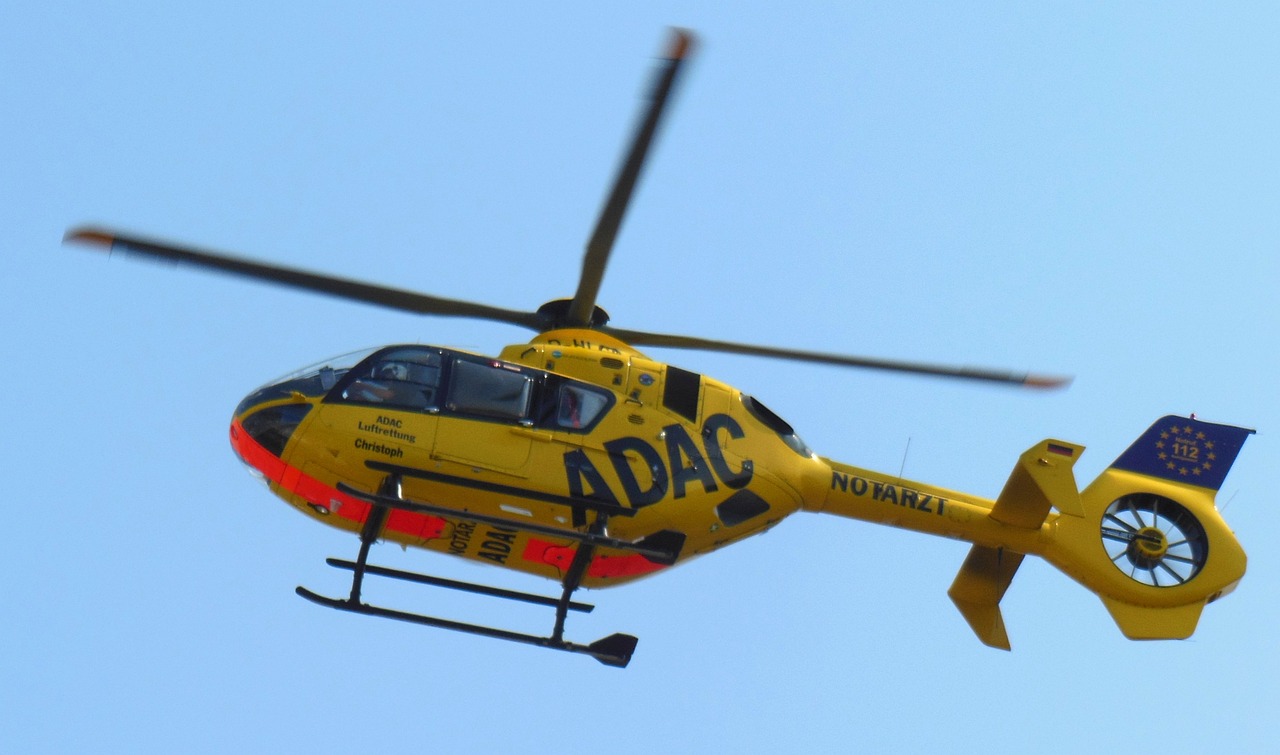
Natural Language Processing
Natural Language Processing (NLP) is revolutionizing the way search and rescue teams communicate in high-pressure environments. Imagine a chaotic battlefield where every second counts, and the ability to convey information accurately can mean the difference between life and death. With NLP, rescue teams can interpret and respond to voice commands in real-time, making communication seamless and efficient. This technology enables team members to focus on their critical tasks without getting bogged down by misunderstandings or language barriers.
One of the standout features of NLP is its ability to understand context and intent. For instance, if a team leader shouts, "We need medical assistance at sector five!" the NLP system can process this command instantly and relay it to the appropriate units, ensuring that help is dispatched without delay. This capability is especially vital in combat situations where traditional communication methods may falter due to noise, stress, or equipment failure.
Additionally, NLP can be integrated with various communication tools to enhance situational awareness. For example, it can analyze incoming voice data from multiple sources, filtering out unnecessary noise and highlighting critical information. This ensures that team members are always aware of the evolving situation around them.
Furthermore, NLP can also facilitate communication between diverse teams operating in multilingual environments. With the help of AI-driven translation tools, rescue teams can break down language barriers, allowing for smooth collaboration among team members from different backgrounds. This is particularly important in international missions where personnel may not share a common language.
To illustrate the impact of NLP in search and rescue operations, consider the following table that summarizes its key benefits:
| Benefit | Description |
|---|---|
| Enhanced Communication | NLP allows for quick and accurate interpretation of voice commands, reducing the risk of miscommunication. |
| Context Awareness | Understanding the context of commands helps teams respond more effectively to evolving situations. |
| Language Translation | AI-powered translation tools facilitate communication in multilingual teams, enhancing collaboration. |
| Noise Filtering | NLP systems can filter out background noise, focusing on critical information from voice commands. |
In summary, Natural Language Processing is a game-changer for search and rescue operations in combat situations. By streamlining communication, fostering collaboration, and ensuring that critical information is conveyed effectively, NLP empowers rescue teams to operate at their best, even in the most challenging environments. As technology continues to advance, the role of NLP in these operations is only expected to grow, potentially saving more lives in the process.
- What is Natural Language Processing (NLP)?
NLP is a field of artificial intelligence that focuses on the interaction between computers and humans through natural language. It enables machines to understand, interpret, and respond to human language in a valuable way.
- How does NLP improve communication in search and rescue operations?
NLP enhances communication by allowing team members to issue voice commands that are quickly interpreted and acted upon, reducing the chances of miscommunication during critical moments.
- Can NLP work in multilingual environments?
Yes, NLP can integrate with translation tools to facilitate communication among team members who speak different languages, ensuring that vital information is shared effectively.

Real-Time Language Translation
This article explores how artificial intelligence enhances the efficiency and effectiveness of search and rescue operations in combat situations, highlighting its applications, benefits, and challenges faced by rescue teams.
AI systems can analyze vast amounts of data quickly, assisting rescue teams in making informed decisions during critical situations. This capability significantly improves response times and operational efficiency in combat environments.
Utilizing AI for real-time data analysis allows search and rescue teams to assess evolving situations swiftly. This ensures that resources are allocated effectively and that teams are aware of potential hazards.
Drones equipped with AI technology can autonomously search large areas, providing real-time imagery and data. This integration enhances situational awareness and helps locate missing personnel faster.
AI-driven drones can navigate complex terrains without human intervention, reducing the risk to rescue teams. Their ability to adapt to changing environments makes them invaluable in combat search scenarios.
Drones can collect vital data during missions and transmit it back to command centers. This capability allows for better planning and coordination among rescue teams on the ground.
AI employs predictive analytics to forecast potential rescue scenarios based on historical data. This foresight helps teams prepare for various contingencies and allocate resources more effectively.
AI enhances communication systems used in search and rescue operations, ensuring that teams remain connected even in challenging environments. This reliability is crucial for successful mission execution.
Natural language processing (NLP) allows AI systems to interpret and respond to voice commands, streamlining communication between team members and command centers during high-pressure situations.
In the chaotic environment of combat search and rescue operations, effective communication can be the difference between success and failure. This is where powered by AI comes into play. Imagine a scenario where rescue teams from different countries are working together. Without a common language, vital information can easily be lost in translation. AI-driven translation tools bridge this gap, enabling seamless communication among diverse teams.
These tools utilize advanced algorithms to translate spoken or written language in real time, allowing team members to share critical information instantly. For instance, if a team member shouts, “We need medical supplies!” in their native tongue, an AI translator can convert this message into the language of another team member, ensuring everyone is on the same page.
Moreover, the benefits of real-time language translation in rescue operations include:
- Immediate Understanding: Team members can comprehend instructions and updates without delay.
- Cultural Sensitivity: AI translation tools can incorporate cultural nuances, reducing the risk of misunderstandings.
- Enhanced Collaboration: Multinational teams can work more effectively, fostering an environment of cooperation.
As these translation systems evolve, they will likely incorporate machine learning techniques to improve accuracy over time. This means that the more they are used, the better they become at understanding context and delivering precise translations. In high-stakes situations, this capability can save lives.
- How does AI improve decision-making in rescue operations?
AI systems analyze data swiftly, enabling teams to make informed decisions quickly. - What role do drones play in search and rescue?
Drones equipped with AI can autonomously search large areas and provide real-time data, enhancing situational awareness. - Can AI help with language barriers in rescue operations?
Yes, AI-driven real-time language translation tools facilitate communication among multilingual teams. - How does predictive analytics benefit rescue teams?
It allows teams to forecast potential scenarios based on historical data, improving resource allocation.
Frequently Asked Questions
- How does AI improve decision-making in combat search and rescue operations?
AI enhances decision-making by rapidly analyzing vast amounts of data, allowing rescue teams to make informed choices during critical moments. This capability leads to quicker response times and improves operational efficiency in high-pressure environments.
- What role do drones play in AI-enhanced search and rescue?
Drones equipped with AI technology autonomously search large areas, providing real-time imagery and data. This integration significantly boosts situational awareness and accelerates the process of locating missing personnel in combat scenarios.
- Can AI predict potential rescue scenarios?
Yes! AI utilizes predictive analytics to forecast possible rescue scenarios based on historical data. This foresight allows teams to prepare for various contingencies and allocate their resources more effectively.
- How does AI improve communication in rescue operations?
AI enhances communication systems by ensuring that teams remain connected, even in challenging environments. Features like natural language processing allow AI to interpret voice commands, streamlining communication during intense situations.
- Is AI capable of real-time language translation?
Absolutely! AI-powered translation tools facilitate communication in multilingual environments, ensuring that all team members can understand critical information. This significantly enhances collaboration and effectiveness during rescue operations.
- What challenges do rescue teams face when implementing AI?
While AI offers many benefits, challenges include the need for reliable technology in harsh environments, the requirement for proper training for team members, and potential issues with data privacy and security.
- How does AI assist in navigating complex terrains?
AI-driven drones can autonomously navigate complex terrains without human intervention. Their ability to adapt to changing environments makes them invaluable in combat search scenarios, reducing risks for rescue teams.


